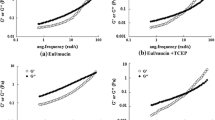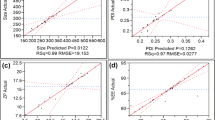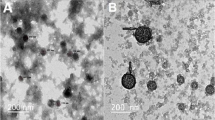Abstract
Purpose
Colloidal metallic systems have been recently investigated in the area of nanomedicine. Gold nanoparticles have found themselves useful for diagnostic and drug delivery applications. Herein we have reported a novel method for synthesis of gold nanoparticles using a natural, biocompatible and biodegradable polymer; chitosan. Use of chitosan serves dual purpose by acting as a reducing agent in the synthesis of gold nanoparticles and also promotes the penetration and uptake of peptide hormone insulin across the mucosa. To demonstrate the use of chitosan reduced gold nanoparticles as carriers for drug delivery, we report herein the transmucosal delivery of insulin loaded gold nanoparticles.
Materials and Methods
Gold nanoparticles were prepared using different concentrations of chitosan (from 0.01% w/v up to 1% w/v). The gold nanoparticles were characterized for surface plasmon band, zeta potential, surface morphology, in vitro diffusion studies and fluorescence spectroscopy. The in vivo studies in diabetic male Wistar rats were carried out using insulin loaded chitosan reduced gold nanoparticles.
Results
Varying concentrations of chitosan used for the synthesis of gold nanoparticles demonstrated that the nanoparticles obtained at higher chitosan concentrations (>0.1% w/v) were stable showing no signs of aggregation. The nanoparticles also showed long term stability in terms of aggregation for about 6 months. Insulin loading of 53% was obtained and found to be stable after loading. Blood glucose lowering at the end of 2 h following administration of insulin loaded gold nanoparticles to diabetic rats was found to be 30.41 and 20.27% for oral (50 IU/kg) and nasal (10 IU/kg), respectively. Serum gold level studies have demonstrated significant improvement in the uptake of chitosan reduced gold nanoparticles.
Conclusions
The synthesis of gold nanoparticles using a biocompatible polymer, chitosan would improve its surface properties for binding of biomolecules. Our studies indicate that oral and nasal administration of insulin loaded chitosan reduced gold nanoparticles has led to improved pharmacodynamic activity. Thus, chitosan reduced gold nanoparticles loaded with insulin prove to be promising in controlling the postprandial hyperglycemia.











Similar content being viewed by others
Abbreviations
- BGL:
-
blood glucose levels
- p.o.:
-
peroral
- i.n.:
-
intranasal
- SPB:
-
surface plasmon band
References
K. A. Janes, and M. J. Alonso. Depolymerised chitosan nanoparticles for protein delivery: preparation and characterization. J. Appl. Polym. Sci. 88:2769–2776 (2003).
S. Shukla, A. Priscilla, M. Banerjee, R. R. Bhonde, J. Ghatak, P. V. Satyam, and M. Sastry. Porous gold nanospheres by controlled transmetallation reaction: a novel material for apllication in cell imaging. Chem. Mater. 17:5000–5005 (2005).
W. C. W. Chan and S. Nie. Quantum dot bioconjugates for ultrasensitive non-isotopic detection. Science 281:2016–2018 (1998).
T. Jung, W. Kamm, A. Breitenbach, E. Kaiserling, J. X. Xiao, and T. Kissel. Biodegradable nanoparticles for oral delivery of peptides: is there a role for polymers to affect mucosal uptake? Eur. J. Pharm. Biopharm. 50:147–160 (2000).
H. Chen and R. Langer. Oral particulate delivery: status and future trends. Adv. Drug Deliv. Rev. 34:339–350 (1998).
T. H. Ermak and P. J. Giannasca. Microparticle targeting to M cells. Adv. Drug Deliv. Rev. 34:261–283 (1998).
G. A. Hughes. Nanostructure-mediated drug delivery. Nanomedicine: Nanotechnology, Biology, and Medicine 1:22–30 (2005).
H. Joshi, P. S. Shirude, V. Bansal, K. N. Ganesh, and M. Sastry. Isothermal titration calorimetry studies on the binding amino acid to gold nanoparticles. J. Phys. Chem., B. 108:11535–11540 (2004).
S. S. Shankar, A. Rai, A. Ahmad, and M. Sastry. Controlling the optical properties of lemongrass extract synthesized gold nanoparticles and potential application in infrared absorbing optical coatings. Chem. Mater. 17:566–572 (2005).
R. Shukla, V. Bansal, M. Chaudhary, A. Basu, R. Bhonde, and M. Sastry. Biocompatibility of gold nanoparticles and their endocytotic fate inside the cellular compartment: a microscopic overview. Langmuir 21:10644–10654 (2005).
H. M. Joshi, D. R. Bhumkar, K. Joshi, V. Pokharkar, and M. Sastry. Gold nanoparticles as carriers for efficient transmucosal insulin delivery. Langmuir 22:300–305 (2006).
A. P. Alivisatos, X. Peng, T. E. Wilson, C. L. Loweth, M. P. Bruchez Jr, and P. G. Schultz. Organization of nanocrystal molecules using DNA. Nature 382:609–611 (1996).
R. S. Ingram, M. J. Hostetler, and R. W. Murray. Poly-hetero-ω-functionalized alkanethiolate-stabilized gold cluster compounds. J. Am. Chem. Soc. 119:9175–9178 (1997).
C. M. Niemeyer. Nanoparticles, proteins, and nucleic acids: Biotechnology meets materials science. Angew. Chem., Int. Ed. 40:4128–4158 (2001).
A. Bielinska, J. D. Eichman, I. Lee, J. R. Baker Jr, and L. Balogh. Imaging {Au°-PAMAM} gold-dendrimer nanocomposites in cells. J. Nanopart. Res. 4:395–403 (2002).
M. Thomas and M. A. Klibanov. Conjugation to gold nanoparticles enhances polyethylenimine’s transfer of plasmid DNA into mammalian cells. Proc. Natl. Acad. Sci. U.S.A. 100:9138–9143 (2003).
L. Ren and G. M. Chow. Synthesis of nir-sensitive Au-Au2S nanocolloids for drug delivery. Mater. Sci. Eng., C. 23:113–116 (2003).
H. Gu, P. L. Ho, E. Tong, L. Wang and B. Xu. Presenting vancomycin on nanoparticles to enhance antimicrobial activities. Nano Lett. 3:1261–1263 (2003).
L. R. Hirsch, R. J. Stafford, J. A. Bankson, S. R. Sershen, B. Rivera, R. E. Price, J. D. Hazle, N. J. Halas, and J. L. West. Nanoshell-mediated near-infrared thermal therapy of tumors under magnetic resonance guidance. Proc. Natl. Acad. Sci. U.S.A. 100:13549–13554 (2003).
M. C. Daniel and D. Astruc. Gold nanoparticles: assembly, supramolecular chemistry, quantum-size-related properties, and applications toward biology, catalysis, and nanotechnology. Chem. Rev. 104:293–346 (2004).
M. Brust, M. Walker, D. Bethell, D. J. Schiffrin, and R. Whyman. Synthesis of thiol-derivatised gold nanoparticles in a two-phase liquid–liquid system. J. Chem. Soc., Chem. Commun. 7:801–802 (1994).
A. Silva-Cunha, M. Cheron, J. L. Grossiord, F. Puisieux, and M. Seiller. W/O/W multiple emulsions of insulin containing a protease inhibitor and an absorption enhancer: biological activity after oral administration to normal and diabetic rats. Int. J. Pharm. 169:33–44 (1998).
G. De Rosa, R. Lommelli, M. L. La Rotonda, A. Miro, and F. Quaglia. Influence of the co-encapsulation of different non-ionic surfactants on the properties of PLGA insulin-loaded microspheres. J. Control. Release 69:283–295 (2000).
E. A. Hosny, H. I. Al-Shora, and M. M. A. Elmazar. Oral delivery of insulin from enteric-coated capsules containing sodium salicylate: effect on relative hypoglycemia of diabetic beagle dogs. Int. J. Pharm. 237:71–76 (2002).
V. Agarwal, I. K. Reddy, and M. A. Khan. Polymethacrylate based microparticulates of insulin for oral delivery: preparation and in vitro dissolution stability in the presence of enzyme inhibitors. Int. J. Pharm. 225:31–39 (2001).
L. Illum. Chitosan and its use as a pharmaceutical excipient. Pharm. Res. 15:1326–1331 (1998).
O. Felt, P. Buri, and R. Gurny. Chitosan: a unique polysaccharide for drug delivery. Drug Dev. Ind. Pharm. 24:979–993 (1998).
Y. Pan, Y. Li, H. Zhao, J. Zheng, H. Xu, G. Wei, J. Hao, and F. Cui. Bioadhesive polysaccharide in protein delivery system: chitosan nanoparticles improve the intestinal absorption of insulin in vivo. Int. J. Pharm. 249:139–147 (2002).
Z. Ma, T. M. Lim, and L. Lim. Pharmacological activity of peroral chitosan-insulin nanoparticles in diabetic rats. Int. J. Pharm. 293:271–280 (2005).
I. M. V. Lubben, J. C. Verhoef, G. Borchard, and H. E. Junginger. Chitosan for mucosal vaccination. Adv. Drug Del. Rev. 52:139–144 (2001).
E. Bjork and P. Edman. Degradable starch microspheres as a nasal delivery system for insulin. Int. J. Pharm. 47:233–238 (1988).
I. M. V. Lubben, J. C. Verhoef, G. Borchard, and H. E. Junginger. Chitosan and its derivatives in mucosal drug and vaccine delivery. Eur. J. Pharm. Sci. 14:201–207 (2001).
A. Martin, J. Swarbrick, and A. Cammarata. Physical Pharmacy. Varghese, Mumbai, 1991.
I. Bertholon, G. Ponchel, D. Labarre, P. Couvreur, and C. Vauthier. Bioadhesive properties of poly (alkylcyanoacrylate) nanoparticles coated with polysaccharide. J. Nanosci. Nanotech. 6:3102–3109 (2006).
D. Cremaschi, S. Dossena, C. Porta, V. Rossi, and M. Pinza. Further analysis of transcytosis of free polypeptides and polypeptide-coated nanobeads in rabbit nasal mucosa. J. Appl. Physiol. 91:211–217 (2001).
R. Narayani. Oral delivery of insulin-making needles needless. Trends Biomater. Artif. Organs 15:12–16 (2001).
J. A. Galloway, C. T. Spradlin, R. L. Nelson, S. M. Wentworth, J. A. Davidson, and J. L. Swarner. Factors influencing the absorption, serum insulin concentration, and blood glucose responses after injections of regular insulin and various insulin mixtures. Diabetes Care 4:366–376 (1981).
F. A. Dorkoosh, J. C. Verhoef, G. Borchard, M. Rafiee-Tehrani, J. H. M. Verheijden, and H. E. Junginger. Intestinal absorption of human insulin in pigs using delivery systems based on superporous hydrogel polymers. Int. J. Pharm. 247:47–55 (2002).
A. M. Lowman, M. Morishita, M. Kajita, T. Nagai, and N. A. Peppas. Oral delivery of insulin using pH-responsive complexation gels. J. Pharm. Sci. 88:933–937 (1999).
D. A. Norris, N. Puri, and P. J. Sinko. The effect of physical barriers and properties on the oral absorption of particulates. Adv. Drug Deliv. Rev. 34:135–154 (1998).
J. Blanchette, N. Kavimandan, and N. A. Peppas. Principles of transmucosal delivery of therapeutic agents. Biomed. Pharmacother. 58:142–151 (2004).
P. Yeh, H. Ellens, and P. L. Smith. Physiological considerations in the design of particulate dosage forms for oral vaccine delivery. Adv. Drug Deliv. Rev. 34:123–133 (1998).
L. Illum. Nasal drug delivery-possibilities, problems and solutions. J. Control. Release 87:187–198 (2003).
L. Illum. Transport of drugs from the nasal cavity to the central nervous system. Eur. J. Pharm. Sci. 11:1–18 (2000).
L. Illum. Nasal drug delivery: new developments and strategies. Drug Discov. Today 7:1184–1189 (2002).
Acknowledgements
DRB is thankful to the Fair & Lovely Foundation, for providing financial assistance in form of Project Saraswati Scholarship. The authors are thankful to Dr. Madhusudan Rao for providing the facility of zeta sizer.
Author information
Authors and Affiliations
Corresponding author
Rights and permissions
About this article
Cite this article
Bhumkar, D.R., Joshi, H.M., Sastry, M. et al. Chitosan Reduced Gold Nanoparticles as Novel Carriers for Transmucosal Delivery of Insulin. Pharm Res 24, 1415–1426 (2007). https://doi.org/10.1007/s11095-007-9257-9
Received:
Accepted:
Published:
Issue Date:
DOI: https://doi.org/10.1007/s11095-007-9257-9




